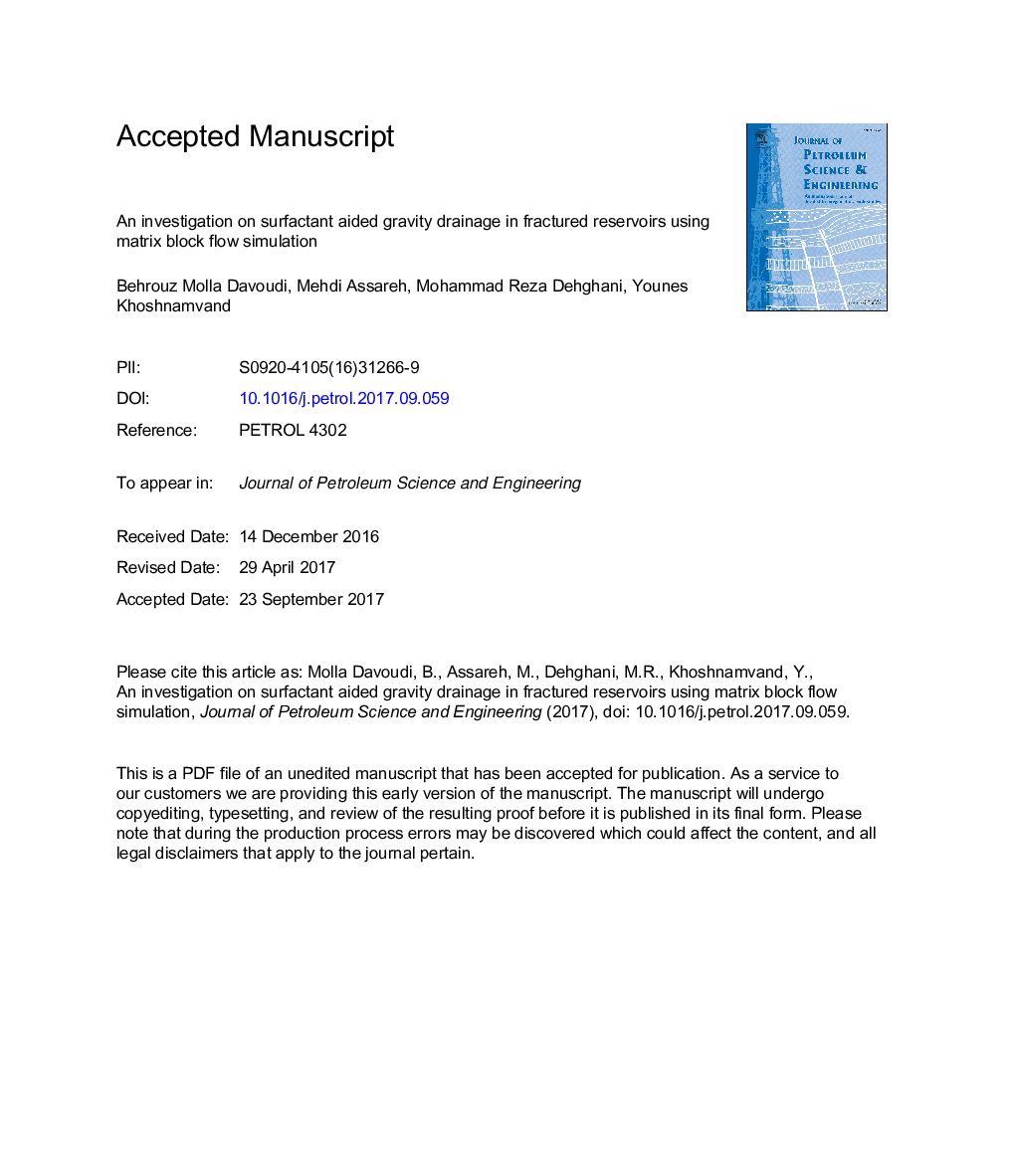| کد مقاله | کد نشریه | سال انتشار | مقاله انگلیسی | نسخه تمام متن |
|---|---|---|---|---|
| 8125599 | 1522782 | 2017 | 56 صفحه PDF | دانلود رایگان |
عنوان انگلیسی مقاله ISI
An investigation on surfactant aided gravity drainage in fractured reservoirs using matrix block flow simulation
ترجمه فارسی عنوان
تحقیق در مورد سورفاکتانت در تخلیه گرانش در مخازن شکسته با استفاده از شبیه سازی جریان بلوک ماتریس
دانلود مقاله + سفارش ترجمه
دانلود مقاله ISI انگلیسی
رایگان برای ایرانیان
کلمات کلیدی
سورفاکتانت، زهکشی جاذب، کاپیتالیسم، جذب، روغن سنگ مرطوب
ترجمه چکیده
نیروهای مویرگی و گرانش مکانیسم کنترل در بازیابی مخازن شکسته است. بیشتر مخازن شکسته شده تشکیلات کربنات با سنگ های مخلوط مرطوب و روغن است. یکی از تکنیک هایی که برای بهبود بازیابی نفت از این مخازن است، درمان سطحی واکنش در ناحیه آلودگی کربناته شکسته ای است که شناخته شده به عنوان تخلیه گرانشی سورفاکتانت شناخته شده است. تعدادی از مطالعات تجربی و مدل سازی در این منطقه تحقیقاتی در دسترس هستند اما روش مدل سازی با داده های تجربی معتبر برای در نظر گرفتن شرایط مختلف مخزن، از جمله فیزیک سنگ، خواص مایع، شوری آب و ویژگی های سورفکتانت هنوز یک عنصر ضروری قبل از آزمایش های آزمایشی برای این روش بازیابی. در این مقاله یک رویکرد مدل سازی برای ارائه بینش به جنبه های مهندسی این فرایند ارائه شده است. این یک ماتریس مخروطی (مقیاس هسته ای) محصور شده توسط محلول سورفکتانت-نمک در محل شکستگی است که به عنوان مرز برای ماتریس در یک سناریوی آزمون ورودی تعریف می شود. سنگ مخزن روغن مرطوب است، بنابراین در ابتدا، نیروهای انتشاری راه حل را به ماتریس هدایت می کند که منجر به تغییرات خیس شدن می شود. پس از آن، تحریم ضد جریان در ابتدای دوره متوسط زمان آزمایش انجام می شود. در نهایت، تخلیه گرانش فرایند بازیابی را کنترل می کند. تجزیه و تحلیل پارامتری اثرات پارامترهای مختلف را بررسی می کند. تغییرات مختلف در مورد پایه (با داده های آزمایشی معتبر) برای هر پارامتر انجام می شود و سپس منحنی های بازیابی حاصل از آن با بهبود وضعیت پایه مقایسه می شود. مطالعه پارامتری نشان می دهد که تراکم مایع، ارتفاع، نسبت آنیزوتروپی، نفوذپذیری، اشباع آب اتصالی، فشار مویی و نقاط پایین اشباع، پارامترهای اصلی موثر بر عملکرد زهکشی گرانشی با سورفاکلات هستند. این مطالعه حساسیت فرآیند را به تغییرات پارامترهای فرآیند جابجایی اصلی موثر نشان می دهد.
موضوعات مرتبط
مهندسی و علوم پایه
علوم زمین و سیارات
زمین شناسی اقتصادی
چکیده انگلیسی
Capillary and gravity forces are the controlling mechanisms in fractured reservoirs recovery. Most of the fractured reservoirs are carbonate formations with mixed wet and oil wet rocks. One of the techniques to improve the oil recovery from these reservoirs is surfactant treatment in the water invaded zone of carbonate fractured formation known as surfactant-aided gravity drainage. A number of experimental and modeling studies are available in this research area however, a modeling approach validated with the experimental data to consider different conditions in the reservoir, including rock physics, fluid properties, water salinity and surfactant functionalities is still a necessary element before the pilot tests for this recovery technique. In this work, a modeling approach is proposed to provide insight into the engineering aspects of this process. It defines a reservoir rock matrix (core scale) surrounded by the surfactant-brine solution in the fracture that acts as a boundary for the matrix in an imbibition test scenario. The reservoir rock is oil wet, therefore at first, the diffusive forces drive the solution into the matrix leading to wettability alteration. Afterwards the counter-current imbibition takes place in the early through the middle time of the experiment. Finally, the gravity drainage controls the recovery process. The parametric analysis investigates the effects of various parameters. Different modifications to the base case (validated with the experimental data) are performed for each parameter and then the resultant recovery curves are compared with the base case recovery. The parametric study shows that fluid densities, height, anisotropy ratio, permeability, connate water saturation, capillary pressure and the saturation end-points, are the main parameters influencing the performance of surfactant-aided gravity drainage. This study highlights the process sensitivity to the changes of the main effective displacement process parameters.
ناشر
Database: Elsevier - ScienceDirect (ساینس دایرکت)
Journal: Journal of Petroleum Science and Engineering - Volume 159, November 2017, Pages 977-987
Journal: Journal of Petroleum Science and Engineering - Volume 159, November 2017, Pages 977-987
نویسندگان
Behrouz Molla Davoudi, Mehdi Assareh, Mohammad Reza Dehghani, Younes Khoshnamvand,
